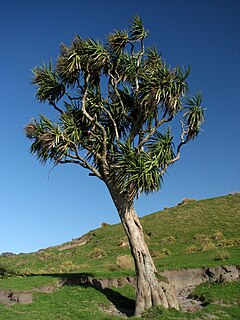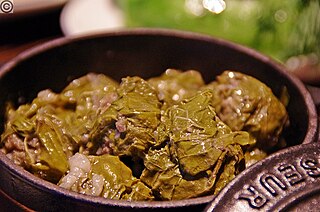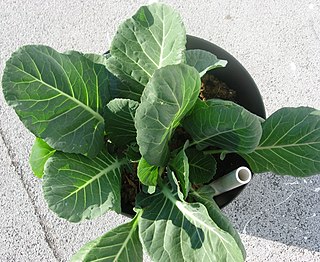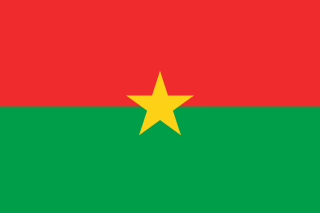
Cabbage is a leafy green, red (purple), or white biennial plant grown as an annual vegetable crop for its dense-leaved heads. It is descended from the wild cabbage, and belongs to the "cole crops" or brassicas, meaning it is closely related to broccoli and cauliflower ; Brussels sprouts ; and Savoy cabbage.

Cordyline australis, commonly known as the cabbage tree or cabbage-palm, is a widely branched monocot tree endemic to New Zealand.

Dolma is a family of stuffed dishes found in the Balkans, South Caucasus, Central Asia and the Middle East, in which a vegetable or leaf is used as a container or wrapping for another food used as a filling. Common vegetables for stuffing are tomato, pepper, onion, zucchini, eggplant and pointed gourd. Stuffed cabbage rolls and vine leaves are also very popular, which are sometimes also called sarma. Meat dolmas are generally served warm, often with tahini or avgolemono sauce. Dolmas prepared with olive oil and stuffed with rice are generally served cold with a garlic-yogurt sauce.

Brassica oleracea is a plant species that includes many common foods as cultivars, including cabbage, broccoli, cauliflower, kale, Brussels sprouts, collard greens, Savoy cabbage, kohlrabi, and gai lan.

Andira inermis is a nitrogen-fixing tree native to the area from southern Mexico through Central America to northern South America ; it has been introduced to the Caribbean, the Antilles, Florida, and Africa. The tree has many names due to its wide distribution and multiple uses: it is also known as the cabbage bark, almendro macho, almendro de río or river almond (Honduras), bastard cabbage tree, cabbage angelin, cabbage bark, cabbage tree, carne asada, guacamayo (Honduras), Jamaica cabbage tree, harino (Panama), moca, partridge wood, worm bark, or yellow cabbage tree.
Cabbage tree is a common name for several plant species:

Sarma, commonly marketed as stuffed grape leaves, is a type of dolma—a stuffed dish of the cuisines of the former Ottoman Empire from the Middle East to Southeastern Europe—comprising vine, cabbage, monk's rhubarb, kale or chard leaves rolled around a filling of grains, minced meat, or both.

Cussonia spicata, known as spiked cabbage tree, lowveld cabbage tree or common cabbage tree, is a tree in the family Araliaceae, which is native to the moister regions of Sub-Saharan Africa. It is cultivated as a garden plant in areas without extreme degrees of frost. It is one of the favorite foods of wild elephants.

The acephala group refers to any type of Brassica which grows without the central 'head' typical of many varieties of cabbage. These are included within the species Brassica oleracea, such as Kale. The name literally means "without a head" in contrast to those varieties known as capitata or "with a head". This group includes a number of species, both wild and cultivated, many of which are grown for their edible leaves and flowers.

Kinilnat, or ensalada, is an Ilocano salad. Popular vegetables that are used as ingredients to this dish include the shoots and leaves of the sweet potato and bitter melon, shoots and the fruits of the string bean, and horseradish tree leaves and blossoms, taro, cabbage, blossoms of the West-Indian pea, and winged beans, fern shoots, or other various vegetables such as eggplant. The leaves, shoots, blossoms, or the other parts of the plant are blanched, drained and dressed with bagoong (preferably) or patis, and sometimes souring agents like calamansi or cherry tomatoes are added, as well as freshly ground ginger.

Cordyline indivisa is a monocot tree endemic to New Zealand, where it is called mountain cabbage tree or bush flax. It is also known as the broad-leaved cabbage tree, and in the Māori language as tōī.

Livistona australis, the cabbage-tree palm, is a plant species in the family Arecaceae. It is a tall, slender palm growing up to about 25 m in height and 0.35 m diameter. It is crowned with dark, glossy green leaves on petioles 2 m long. It has leaves plaited like a fan; the cabbage of these is small but sweet. In summer it bears flower spikes with sprigs of cream-white flowers. The trees accumulate dead fronds or leaves, which when the plant is in cultivation are often removed by an arborist.

Dendroseris litoralis, the cabbage tree, is a small, evergreen tree species belonging the daisy and sunflower family (Asteraceae), with younger trunks ringed with pale leaf scars and distinctive rubbery, leathery leaves up to 46 centimetres (18 in) long. It is found only on the Juan Fernández Islands, west of Chile, and threatened by habitat loss. Native only to tiny, volcanic Robinson Crusoe Island, one of the Juan Fernández Islands in the southeast Pacific, far off the coast of Chile, and home of the famed Juania australis and many other fascinating endemic plants, this strange, small tree has literally been brought back from the brink of extinction. It had been reduced to only a few individuals by feral goats on the island and is still considered critically endangered. It grows into a small, gnarled tree with several somewhat palm-like crowns of very large, ovate leaves on whitish, green-spotted leaf stalks and pendent inflorescences of bright orange, tassel-like 'flowers' (capitula). It is easy to cultivate and enjoys a cool, humid climate. It is hardy to light freezes and coastal conditions.

Cordyline obtecta is a widely branching monocot tree native to Norfolk Island, and to northern New Zealand. The species name obtecta derives from the Latin obtegere, alluding to the way the inflorescence barely protruded beyond the leaves in the plant first described.

Sabal palmetto, also known as cabbage-palm, palmetto, cabbage palmetto, blue palmetto, Carolina palmetto, common palmetto, swamp cabbage and sabal palm, is one of 15 species of palmetto palm. It is native to the Southern United States, as well as Cuba, the Turks and Caicos Islands, and the Bahamas.

Burkinabé cuisine, the cuisine of Burkina Faso, is similar to the cuisines in many parts of West Africa, and is based on staple foods of sorghum, millet, rice, fonio, maize, peanuts, potatoes, beans, yams and okra. Rice, maize and millet are the most commonly eaten grains. Grilled meat is common, particularly mutton, goat, beef and fish.

Epiphryne verriculata, the cabbage tree moth, is a moth in the family Geometridae. It is found only in New Zealand, and only feeds on the native cabbage tree ; its wings are patterned to camouflage it against dead cabbage tree leaves.

Cordyline pumilio, commonly known as the dwarf cabbage tree, pygmy cabbage tree or by its Māori names tī koraha or tī rauriki, is a narrow-leaved monocot shrub endemic to New Zealand. It usually grows up to 1 metre tall, although rare examples of 2 metres tall have been reported. It has long leaves and can easily be mistaken for a grass or a sedge. C. pumilio grows in the north of the North Island from North Cape at 34°S to Kawhia and Opotiki at about 38°S, generally under light forest and scrub. It was cultivated by Māori as a source of carbohydrate and used as a relish to sweeten less palatable foods.

Boondelbah Island, also known as the Boondelbah Nature Reserve, is a protected nature reserve and uninhabited island lying 2 kilometres (1.2 mi) off the mouth of Port Stephens on the coast of New South Wales, Australia. The 14-hectare (35-acre) reserve and island is one of two breeding sites of the nominate subspecies of the threatened Gould's petrel and, with the nearby Cabbage Tree Island which hosts the principal colony, has been classified by BirdLife International as an Important Bird Area.

A cabbage tree hat is a hat made from the leaves of the Livistona australis, also known as the cabbage-tree palm. It is known as the first distinctively Australian headwear in use. Seeking protection from the sun, early European settlers started to make hats using fibre from the native palm, which soon became popular throughout the colonies. The process involved boiling, then drying, and finally bleaching the leaves. The Powerhouse Museum describes a cabbage-tree hat thus: "Finely woven natural straw coloured hat; high tapering domed crown, wide flat brim; applied layered hat band of coarser plaiting with zig-zag border edges."


















